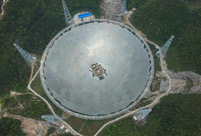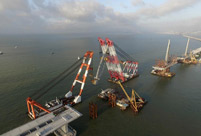

The Democratic People's Republic of Korea (DPRK) fired one ballistic missile into east waters from its west region, South Korea's Joint Chiefs of Staff (JCS) said on Wednesday.
The projectile was launched eastward from South Hwanghae province at about 7:50 a.m. local time, a JCS official said on the phone. Further details are being analyzed, the official added.
The launch came after the DPRK test-fired two medium-range Rodong ballistic missiles and one shorter-range Scud missile on July 19 in an apparent protest against the decision between Seoul and Washington to deploy Terminal High Altitude Area Defense on South Korean soil.
On July 8, South Korea and the U.S. abruptly announced an agreement to deploy one THAAD battery by the end of next year. Five days later, the deployment site was designated at Seongju county, some 250 km southeast of Seoul.
One day after the announcement, Pyongyang test-fired a submarine-launched ballistic missile (SLBM) off its east coast to demonstrate against the THAAD deployment decision. In times of military conflict, it is hard to detect and track SLBM with THAAD's X-band radar.
THAAD is incapable of intercepting Rodong and Scud missiles targeting South Korea as the DPRK missiles travel at an altitude of 20-30 km. The U.S. anti-missile system is designed to shoot down missiles at a much higher altitude of 40-150 km.
The DPRK military has threatened to take"physical measures" against the THAAD deployment site. On July 19, Seoul's unification ministry said Pyongyang appeared to have been in a state of conducting another nuclear test at any time given increased activity in its main Punggye-ri nuclear test site.
All of the four DPRK underground nuclear tests had been carried out in Punggye-ri since 2006. The latest took place in January this year.
China and Russia have strongly opposed to THAAD in South Korea as it raises tensions in Northeast Asia.
The U.S. missile defense system also breaks strategic balance in the region and severely damages security interests of China and Russia as the X-band radar can peer into Chinese and Russian territories.
Seoul claims that it will adopt the terminal mode radar with a detectable range of 600-800km, but it can be converted at any time into a forward-based mode capable of detecting at least 2,000 km. The modified version allegedly needs no conversion, spotting as far as 3,000-4,000 km.
South Korea's capital city and its adjacent metropolitan area cannot be protected by the THAAD battery as its interceptors have a maximum range of 200 km. Seongju is about 250 km away from the capital.
It's a clear evidence to support a claim that THAAD in South Korea is not aimed at intercepting DPRK missiles, but supervising and pressuring China and Russia as part of U.S. efforts at its Pivot-to-Asia strategy.
 Who Will Fit The Chinese Roles In Game Of Thrones?
Who Will Fit The Chinese Roles In Game Of Thrones? China's Hubei Shennongjia added to World Heritage List
China's Hubei Shennongjia added to World Heritage List "Straddling bus" starts production in east China
"Straddling bus" starts production in east China Girl goes viral for finger-long toes
Girl goes viral for finger-long toes Five made-in-China hi-tech breakthroughs
Five made-in-China hi-tech breakthroughs HK-Zhuhai-Macao Bridge to open to traffic
HK-Zhuhai-Macao Bridge to open to traffic China opens its first combined transport service to Nepal
China opens its first combined transport service to Nepal Students take stylish bikini graduations photos
Students take stylish bikini graduations photos Charming dancing students pose for graduation photos
Charming dancing students pose for graduation photos Top 10 livable Chinese cities
Top 10 livable Chinese cities Top 20 hottest women in the world in 2014
Top 20 hottest women in the world in 2014 Top 10 hardest languages to learn
Top 10 hardest languages to learn China’s Top 10 Unique Bridges, Highways and Roads
China’s Top 10 Unique Bridges, Highways and Roads The Chinese version of Tomb Raider attracts audiences from around the globe
The Chinese version of Tomb Raider attracts audiences from around the globe Former senior religion official calls on govt to bring house churches out of darkness
Former senior religion official calls on govt to bring house churches out of darkness Chinese tourists cancel trips to South Korea after THAAD
Chinese tourists cancel trips to South Korea after THAAD Exhibition without the exhibitionism
Exhibition without the exhibitionism Day|Week